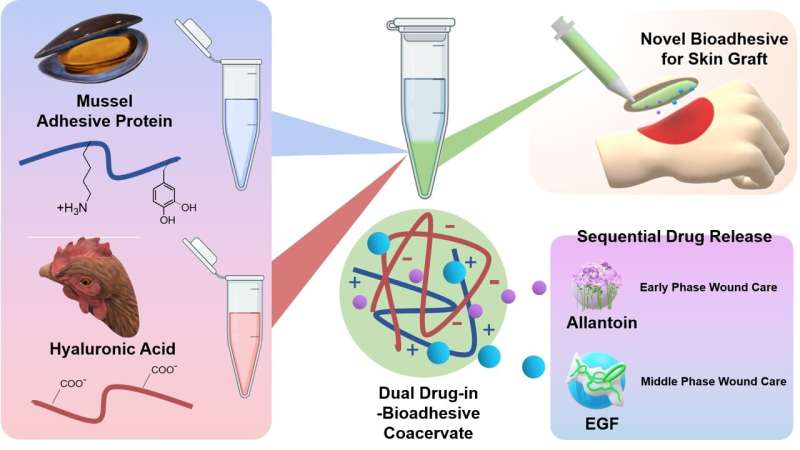Scarless skin grafting using mussel adhesive protein

The biggest concerns for patients undergoing skin grafting are scarring post-surgery and the regeneration of transplanted skin. The depth of scarring after suturing varies depending on the skill of the medical personnel performing the skin grafting, and wound healing at the suture site requires over a month. Recently, a Korean research team has drawn attention for developing a bioadhesive based on the mussel adhesive protein (MAP) that enables quick healing of wounds with minimum scarring. Skin transplantation using this adhesive can effectively revive skin without using sutures.
A research team led by Professor Hyung Joon Cha, Woo Hyung Park and Ph.D. candidate Jae Yun Lee from the Department of Chemical Engineering at POSTECH has developed a bioadhesive for skin grafting containing two types of drugs in collaboration with Dr. Hyo Jeong Kim of the Korea Research Institute of Chemical Technology.
These research findings, proposing a new system for scarless skin grafting, were recently published in the Chemical Engineering Journal.
The research team developed the bioadhesive by introducing allantoin and epidermal growth factor in a mussel adhesive protein coacervate. Upon application of this bioadhesive, the two drugs are successively released, according to the stage of the wound healing process, and regenerate the skin.
Results of the study indicate that the wound area recovered more efficiently than when treated with sutures used in current skin grafting. In particular, loss of hair follicles in the transplanted area was minimal, while collagen and major skin factor levels were effectively revived.
A characteristic of this bioadhesive is that unlike sutures, it leaves minimal scarring on the wound area and is harmless to the human body because it utilizes mussel adhesive protein, a biomaterial.
Professor Hyung Joon Cha explained that they “used the mussel adhesive protein—a biomaterial that originated in Korea—in the newly developed bioadhesive for skin grafting that resulted in minimal scarring and promoted skin regeneration.” He added that “this new system will be effectively applicable in the transplantation of various affected areas requiring tissue regeneration.”
Source: Read Full Article
